|
|
|
|
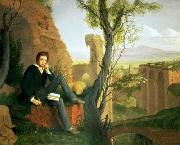 |
Joseph Severn
|
|
(7 December 1793 - 3 August 1879) was an English portrait and subject painter and a personal friend of the famous English poet John Keats. He exhibited portraits, Italian genre, literary and biblical subjects, and a selection of his paintings can today be found in some of the most important museums in London, including the National Portrait Gallery, the Victoria and Albert Museum and the Tate Britain.
The eldest son of a music teacher, Severn was born at Hoxton, near London, and apprenticed at the age of 14 to William Bond, an engraver. Severn was one of seven children; two of his brothers, Thomas (1801-1881) and Charles (1806-1894), became professional musicians, and Severn himself was an adroit pianist. During his early years he practised portraiture as a miniaturist.
|
|
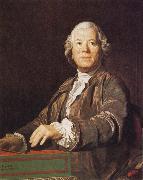 |
Joseph Siffred Duplessis
|
|
French Painter, 1725-1802
was a French painter, known for the clarity and immediacy of his portraits. He was born into a family with an artistic bent and received his first training from his father, a surgeon and talented amateur, then with Joseph-Gabriel Imbert (1666?C1749), who had been a pupil of Charles Le Brun. From 1744-47 or later he worked in Rome, in the atelier of Pierre Subleyras, who was also from the south of France, who died in 1749. In Italy Duplessis became fast friends with Joseph Vernet, another Occitan. He returned to Carpentras, spent a brief time in Lyon then arrived about 1752 in Paris, where he was accepted into the Academie de Saint-Luc and exhibited some portraits, which were now his specialty, in 1764, but did not achieve much notice until his exhibition of ten paintings at the Paris salon of 1769, very well received and selected for special notice by Denis Diderot; the Academie de peinture et de sculpture accepted him in the category of portraitist, considered a lesser category at the time. He continued to exhibit at the Paris salons, both finished paintings and sketches, until 1791, and once more, in 1801. His portrait of the Dauphine in 1771 and his appointment as a peintre du Roi assured his success: most of his surviving portraits date from the 1770s and 1780s. He received privileged lodgings in the Galeries du Louvre. In the Revolution, he withdrew to safe obscurity at Carpentras during the Reign of terror. Afterwards, from 1796, he served as curator at the newly-founded museum formed at Versaillles, so recently emptied of its furnishings at the Revolutionary sales. His uncompromising self-portrait at this time of his life is at Versailles. His adjusted his style to the social condition of his sitter: his portrait of Charles-Claude, comte d'Angiviller, director of the Batiments du Roi, is as distant and conventional as his state portrait of Louis XVI in coronation robes (1776), while his realistic and intimate portrait of the opera composer Christoph Willibald Gluck (Kunsthistorisches Museum, Vienna) catches the composer at the keyboard in a moment of inspiration and his penetrating portrait of the sculptor Christophe Gabriel Allegrain (Louvre Museum, illustration) shows him having just laid down his chisel: this was the morceau de reception that gained him admittance to the Academie. Duplessis' Benjamin Franklin on the U.S. hundred dollar billHis portrait of Benjamin Franklin (1778), |
|
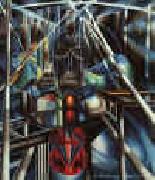 |
Joseph Stella
|
|
1877-1946
Joseph Stella Gallery
Joseph Stella (June 13, 1877 - November 5, 1946) was an Italian-born, American Futurist painter best known for his depictions of industrial America. He is associated with the American Precisionism movement of the 1910s-1940s. He was born in Muro Lucano, Italy but came to New York City in 1896. He studied at the Art Students League of New York under William Merritt Chase. His first paintings are Rembrandtesque depictions of city slum life. In 1908, he was commissioned for a series on industrial Pittsburgh later published in The Pittsburgh Survey.
It was his return to Europe in 1909, and his first contact with modernism, that would truly mold his distinctive personal style.
Returning to New York in 1913, he painted Battle of Lights, Mardi Gras, Coney Island, which is one of the earliest American Futurist works. He is famous for New York Interpreted, a five-paneled work patterned after a religious altarpiece, but depicting bridges and skyscrapers instead of saints. This piece reflects the belief, common at the time, that industry was displacing religion as the center of modern life. It is currently owned by the Newark Museum.
A famous Stella quote is: "I have seen the future and it is good. We will wipe away the religions of old and start anew." |
|
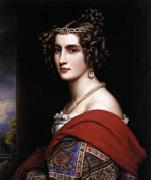 |
Joseph Stieler
|
|
German Painter, 1781-1858,German painter. In 1798 he studied under Christoph Fesel (1737-1805) in Werzburg and in 1800 with Heinrich Feger in Vienna, where his style was strongly influenced by English portraiture. After he studied in Paris (1807-8) with Fran?ois G?rard the influence of Neo-classicism became apparent in his work. He visited Italy in 1809, 1810 and 1812 to do commissioned portraits for various patrons, among them Prince Eugene de Beauharnais (1809; Munich, Bayer. Nmus.) and Joachim Murat, King of Naples (reg 1808-15). In 1812 he went to Munich where he did work for middle-class clients, the nobility and the royal family of Bavaria (e.g. the portrait of Maximilian I Joseph, 1816; Ellingen, Schloss). In 1820 he was appointed court painter to Ludwig I, King of Bavaria (reg 1825-48), and painted several portraits of him. In 1823 he helped co-found the Kunstverein in Munich. He was one of the most important portrait painters in the Neo-classical style, specializing particularly in studies of women, as seen in the 36 portraits commissioned by Ludwig I for the Schenheitsgalerie (1827-42; Munich, Schloss Nymphenburg). In his portraits for the middle classes and for the court he devised certain peculiarities of form. He painted various members of the royal houses of Austria, Prussia and Sweden, as well as members of the nobility in the duchies of Saxe-Altenberg, Saxe-Coburg and Hesse. His sitters also included some of the most important figures in the political and intellectual life of Germany in the first half of the 19th century. He painted the pendant portraits of Franz Brentano and Antonie Brentano (both 1808; Winkel, Brentanohaus), Johann Wolfgang von Goethe (1828; Munich, Neue Pin.) and Ludwig Tieck (1838; Berlin, Schloss Charlottenburg), the geographer and botanist Alexander von Humboldt (1843; Potsdam, Schloss Charlottenhof) and the musician Ludwig van Beethoven (Bonn, Beethoven-Haus). After 1845 the classical elements in his paintings were sometimes combined with an application of colour typical of plein-air studies. He also painted genre pictures and religious scenes. |
|
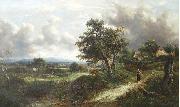 |
Joseph Thors
|
|
(ca. 1835 - 1884) was an English landscape artist who exhibited widely in England during the late 19th century.
Relatively little is known about Thors's life though he was recorded as living and working in London, then Birmingham - he also travelled for a while in France. He exhibited at the Royal Academy of Arts, British Institution, and Society of British Artists in London, and was also exhibited in Birmingham between 1869 - 1900. |
|
|
|
|
|
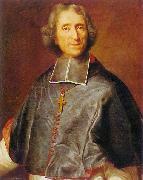 |
Joseph Vivien
|
|
(1657 - 5 December 1735) was a French painter of Lyon.
He left his native Lyon for Paris at the age of twenty and found employment in the large atelier of Charles Le Brun, the equivalent of an academy. He made his reputation by his portraits in pastels, to which he gave a sparkle and immediacy hitherto unreached in that medium.
He was received in the Academie royale de peinture et de sculpture in 1701, under the designation peintre en pastel. He was appointed counsellor to the Academy and provided lodging under royal auspices at the royal manufactory of the Gobelins.
From Paris he visited Brussels. Vivien was taken up by the francophil Elector of Cologne and worked at Munich, as first painter to the Elector's brother, Maximilian Emmanuel, Elector of Bavaria. |
|
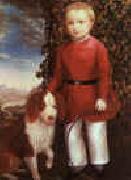 |
Joseph Whiting Stock
|
|
1815-1855
American painter. He was physically handicapped and confined to his house until his doctor advised a wheelchair, which, when placed on a railway carriage, allowed him to travel. He took painting lessons as therapy from Franklin White, a pupil of Chester Harding, and became proficient as an artist. This enabled him to make a living painting portraits, landscapes and miniatures throughout New England and part of New York State. He kept a journal that lists 912 examples of his work executed between 1832 and 1846, with the names of his sitters, canvas sizes, the prices charged and where the pictures were painted. No examples of his landscapes have survived and only a few of his 80 miniatures have been located. The earliest miniatures date from 1836, but most were executed in 1842 and 1845 when he lived in New Bedford, MA. Few American primitive artists of the 19th century were as productive as Stock. |
|
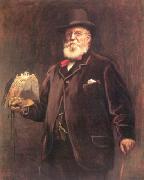 |
Joseph Wolf
|
|
(January 22, 1820 - April 20, 1899) was a German artist who specialized in natural history illustration. He moved to the British Museum in 1848 and became the choice of illustrator for numerous explorers and collectors. He depicted animals accurately in life-like postures and has been considered one of the great pioneers of wildlife art. Sir Edwin Landseer considered him ...without exception, the best all-round animal artist who ever lived.
Wolf was the son of a farmer, and was born in Mörz near Menstermaifeld, not far from the river Moselle, in the Eifel region. In his boyhood he was an assiduous student of bird and animal life, and showed a remarkable capacity as a draughtsman of natural history subjects.
At the age of sixteen he went to Koblenz to work for a firm of lithographers, and then in 1840 he moved to Frankfurt. Here he provided the illustrations for Eduard Reppell's Birds of Northeast Africa. |
|
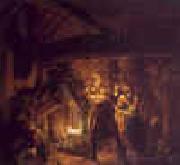 |
Joseph Wright
|
|
1734-1797
British
Joseph Wright Gallery
English painter. He painted portraits, landscapes and subjects from literature, but his most original and enduringly celebrated works are a few which reflect the philosophical and technological preoccupations of the later 18th century and are characterized by striking effects of artificial light. He was the first major English painter to work outside the capital all his life: apart from spells in Liverpool (1768-71), Italy (1773-5) and Bath (1775-7), he lived and worked in his native Derby, though exhibiting in London at both the Society of Artists (1765-76, 1791) and the Royal Academy (1778-82, 1789-90, 1794 |
|
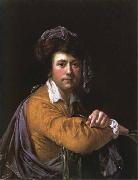 |
Joseph wright of derby
|
|
1734-97
English painter. He painted portraits, landscapes and subjects from literature, but his most original and enduringly celebrated works are a few which reflect the philosophical and technological preoccupations of the later 18th century and are characterized by striking effects of artificial light. He was the first major English painter to work outside the capital all his life: apart from spells in Liverpool (1768-71), Italy (1773-5) and Bath (1775-7), he lived and worked in his native Derby, though exhibiting in London at both the Society of Artists (1765-76, 1791) and the Royal Academy (1778-82, 1789-90, 1794). |
|
 |
Joseph-Benoit Suvee
|
|
(3 January 1743 - 9 February 1807) was a Flemish painter strongly influenced by French neo-classicism.
He was born in Bruges. Initially a pupil of Matthias de Visch, he came to France aged 19 and became a pupil of Jean-Jacques Bachelier. In 1771, he won the Prix de Rome. In Rome from 1772 to 1778, he prolonged the usual duration allowed to pensionaries of the French Academy in Rome. He was named an academician on his return to Paris and he opened an art school for young women at the Louvre. He emulated and competed with Jacques-Louis David, earning his enduring hatred.
Named the French Academy in Rome's director in 1792, replacing François-Guillaume Menageot, he was imprisoned for a while in the Prison Saint-Lazare and only able to take up the post in 1801. After a brilliant career, and a six years' stay in Rome as the Academy's Director, he died there suddenly.
His works include Achilles depositing the body of Hector at the feet of the body of Patroclus, (1769, Louvre), and Cornelia, mother of the Gracchi, (1795, Louvre).
|
|
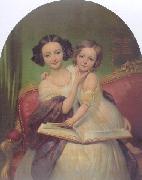 |
Joseph-Desire Court
|
|
a painter of historical subjects and portraits, was born at Rouen in 1797. He became a pupil at the École des Beaux-Arts under Gros, and after carrying off the principal honours there pursued his studies still further at Rome. High expectations were formed of him when he exhibited in 1827 'The Death of Caesar,' a work manifesting earnest thought, and a conscientious handling of the facts of history. This is now preserved in the Louvre. Having shown himself in this and other works a vigorous painter, capable of seizing a subject with a masterly grasp, and having also in the region of portrait painting proved himself an artist of no common merit, he eventually dissipated his talents in the production of a series of empty official pictures painted by order of Louis Philippe. He died in Paris in 1865. The Bordeaux Museum has a portrait of Henri Fonfrede by him; that of Lyons, a 'Scene in the Deluge'; that of Rouen, |
|
|
|
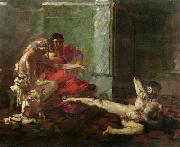 |
Joseph-Noel Sylvestre
|
|
(1847-1926) was a French artist, notable for his studies of classic scenes from antiquity. He was born in Beziers in South-West France on 24 June 1847, training as an artist first in Toulouse under Thomas Couture, then at the École des Beaux-Arts in Paris under Alexandre Cabanel. He was an exponent of the romantic Academic art style, also known as art pompier (fireman's art), examples of which are the Death of Seneca (1875), The Gaul Ducar decapitates the Roman general Flaminus at the Battle of Trasimene (1882), The Sack of Rome by the barbarians in 410 (1890) and François Rude working on the Arc de Triomphe (1893). |
|
 |
Joseph-Siffred Duplessis
|
|
1725-1802
French
Joseph Siffred Duplessis Locations
French painter. He trained with his father, an amateur painter, and then with Joseph-Gabriel Imbert (1666-1749), a pupil of Charles Le Brun. In 1744 he went to Rome and worked with Pierre Subleyras. He remained there until at least 1747 and possibly until the death of his master in 1749. He must have learnt portrait painting in Rome, but he also painted landscapes, because Joseph Vernet advised him to specialize in this genre. |
|
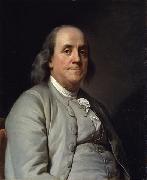 |
Joseph-Siffred Duplessis
|
|
(22 September 1725 - 1 April 1802) was a French painter, known for the clarity and immediacy of his portraits.
He was born in Carpentras, near Avignon, into a family with an artistic bent and received his first training from his father, a surgeon and talented amateur, then with Joseph-Gabriel Imbert (1666-1749), who had been a pupil of Charles Le Brun. From 1744-47 or later he worked in Rome, in the atelier of Pierre Subleyras, who was also from the south of France, who died in 1749. In Italy Duplessis became fast friends with Joseph Vernet, another Occitan.
He returned to Carpentras, spent a brief time in Lyon then arrived about 1752 in Paris, where he was accepted into the Academie de Saint-Luc and exhibited some portraits, which were now his specialty, in 1764, but did not achieve much notice until his exhibition of ten paintings at the Paris salon of 1769, very well received and selected for special notice by Denis Diderot; the Academie de peinture et de sculpture accepted him in the category of portraitist, considered a lesser category at the time. He continued to exhibit at the Paris salons, both finished paintings and sketches, until 1791, and once more, in 1801.
His portrait of the Dauphine in 1771 and his appointment as a peintre du Roi assured his success: most of his surviving portraits date from the 1770s and 1780s. He received privileged lodgings in the Galeries du Louvre. In the Revolution, he withdrew to safe obscurity at Carpentras during the Reign of Terror. Afterwards, from 1796, he served as curator at the newly-founded museum formed at Versaillles, so recently emptied of its furnishings at the Revolutionary sales. His uncompromising self-portrait at this time of his life is at Versailles, where he died.
|
|
|
|
|
|
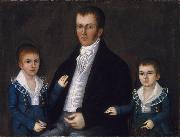 |
Joshua Johnson
|
|
(c.1763-c.1824) was an American biracial painter from the Baltimore area. Johnson, often viewed as the first person of color to make a living as a painter in the United States, is known for his naïve paintings of prominent Maryland residents.
It was not until 1939 that the identity of the painter of elite 19th century Baltimoreans was shed to light by art historian and genealogist J. Hall Pleasants, who believed that thirteen portraits were painted by one Joshua Johnson. Pleasants attempted to put the puzzle of Johnson's life together, however, questions on Johnson's race, life dates and even his last name (Johnson or Johnston) remained. These questions remained up until the mid-1990s, when the Maryland Historical Society released newly found manuscripts regarding Johnson's life |
|
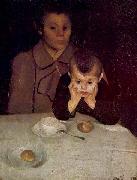 |
Josip Racic
|
|
(1885 - 1908) was a Croatian painter in the early 20th century. Although he died very young (he was only 23), and his work was mostly created when a student, he is one of the best known of the modern Croatian painters. Today, Račić is regarded as one of the most important representatives of Croatian modern painting.
He studied lithography in Zagreb, and 1904 he went to Vienna and Munich, where he studied for a year at the school of the Slovene painter and teacher Anton Ažbe, followed by 3 years at the prestigious Academy of Arts. There, Racic, along with Oskar Herman, Vladimir Becić and Miroslav Kraljević formed the group known as the Croatian School. In 1908, he went to Paris where he painted a series of watercolors and oils depicting Parisian bridges, avenues and parks. He died of a gunshot wound in a Paris hotel room in June 1908, having committed suicide.
Josip Račić is one of the founders of modern Croatian art, the first to bring the concept of self-awareness and artistic integrity to his life and works, "pure painting", as he called it. A particular feature of his paintings is the strong dark realms of human spirituality. A retrospective of his work was held in the Modern Gallery in Zagreb and Dubrovnik in 2008-2009, to mark the 100th anniversary of the artist's death.
|
|
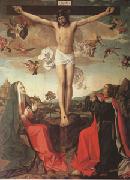 |
Josse Lieferinxe
|
|
active in Provence 1493-1505/08
was a South Netherlandish painter, formerly known by the pseudonym the Master of St. Sebastian. Originating in the diocese of Cambrai in Hainaut, then part of the territories ruled by the Dukes of Burgundy. Josse Lieferinxe was documented as a "Picard" in the regions of Avignon and Marseille at the end of the fifteenth and in the early sixteenth centuries. He was first mentioned in Provence in 1493. Thus he figures among the painters of the Provençal school, whose most prominent members in an earlier generation had also been from the far north of the French-speaking world Barth lemy d'Eyck and Enguerrand Quarton. In 1503 he married Michelle, a daughter of Jean Changenet, the most prominent painter of Avignon, in whose atelier Lieferinxe may have matured his style. He was last mentioned living in 1505, and in 1508 as deceased. Before he was identified by Charles Sterling who linked his work with a document, his artistic personality was recognized, as the "Master of St. Sebastian", through a former retable of eight scenes depicting the acts and miracles of Saint Sebastian and Saint Roch, protectors against the plague, which was commissioned in 1497 for the church of Nôtre Dame des Accoul's in Marseille. Bernardino Sismondi, who originally received the commission, died, however, before he could finish the work. |
|
 |
Jost Amman
|
|
(June 13, 1539, Zerich - March 17, 1591, Nuremberg, Bavaria) was a Swiss artist, celebrated chiefly for his woodcuts, done mainly for book illustrations.
Amman was born in Zurich, the son of a professor of Classics and Logic. He was himself well-educated. Little of his personal history is known beyond the fact that he moved to Nuremberg in 1560, where he continued to reside until his death in March 1591. He worked initially with Virgil Solis, then a leading producer of book illustrations. His productiveness was very remarkable, as may be gathered from the statement of one of his pupils, that the drawings he made during a period of four years would have filled a hay wagon. A large number of his original drawings are in the Berlin print room. About 1,500 prints are attributed to him. He was one of the last major producers of woodcuts for books, as during his career engravings were gradually taking over that role. Although like most artists for woodcut he normally let a specialist formschneider cut the block to his drawing, he sometimes included both a cutter's knife and a quill pen in his signature on prints, suggesting he sometimes cut his own blocks.
A series of engravings by Amman of the kings of France, with short biographies, appeared in Frankfurt in 1576. He also executed many of the woodcut illustrations for the Bible published at Frankfurt by Sigismund Feierabend. Another serial work, the Panoplia Omnium Liberalium Mechanicarum et Seden-tariarum Artium Genera Continens, containing 115 plates, is of great value. Amman's drawing is correct and spirited, and his delineation of the details of costume is minute and accurate. Paintings in oil and on glass are attributed to him, but none have been identified.
|
|
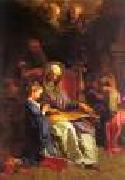 |
JOUVENET, Jean-Baptiste
|
|
French painter (b. 1644, Rouen, d. 1717, Paris).
French painter, one of a family of painters. He worked in Paris in the studio of Charles Le Brun, whose manner he acquired and whose favor at court he shared. He is best known for his religious paintings; the most important are the series of four canvases for St. Martin des Champs, including the Miraculous Draught of Fishes |
|
 |
Jozef Israels
|
|
1824-1911
Dutch
Jozef Israels Gallery
Israels has often been compared to Jean-François Millet. As artists, even more than as painters in the strict sense of the word, they both, in fact, saw in the life of the poor and humble a motive for expressing with peculiar intensity their wide human sympathy; but Millet was the poet of placid rural life, while in almost all Israels' pictures there is some piercing note of woe. Edmond Duranty said of them that they were painted with gloom and suffering.
He began with historical and dramatic subjects in the romantic style of the day. By chance, after an illness, he went to recruit his strength at the fishing-town of Zandvoort near Haarlem, and there he was struck by the daily tragedy of life. Thenceforth he was possessed by a new vein of artistic expression, sincerely realistic, full of emotion and pity.
Among his more important subsequent works are The Zandvoort Fisherman (in the Amsterdam gallery), The Silent House (which gained a gold medal at the Brussels Salon, 1858) and Village Poor (a prize at Manchester).
In 1862 he achieved great success in London with his Shipwrecked, purchased by Mr Young, and The Cradle, two pictures that the Athenaeum magazine described as the most touching pictures of the exhibition. |
|
 |
jozef brandt
|
|
Jozef Brandt (b. Szczebrzeszyn, 1841 - Radom, 1915) was a Polish painter, best known for his paintings of battles.
Brandt studied in Warsaw in the school of J.N. Leszczynski and at the Noblemen Institute. In 1858 he left for Paris to study at the Ecole centrale Paris but was persuaded by Juliusz Kossak to abandon engineering in favor of painting. At one point he studied as a painter under Franz Adam.
|
|
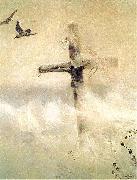 |
Jozef Chelmonski
|
|
(November 7, 1849 -- April 6, 1914) was a Polish painter.
Chełmonski was born in the village of Boczki near Łowicz in central Congress Poland, Russian Empire. His first drawing teacher was his father (a small leaseholder and administrator of Boczki village). After finishing high school in Warsaw, he studied in Warsaw Drawing Class (1867--1871) and took private lessons from Wojciech Gerson. From 1871 to 1874 Chełmonski lived in Munich. He worked with Polish painters assembled around Jozef Brandt and Maksymilian Gierymski. He also had studied for a few months at the academy of H. Anschutz and A. Strahuber. In 1872 and 1874 Chełmonski visited the Polish territories (Poland as a country did not exist then), Tatra Mountains and Ukraine.
His first paintings were done under the influence of Gerson. The works that followed were landscapes and villages. In 1875 Chełmonski went to Paris, where he had many important exhibitions and became known to the art scene. With many orders, the artistic level of his paintings decreased.
From 1878 to 1887 Chełmonski visited Poland, Vienna and Venice. In 1887 he returned to Poland and in 1889 settled in Kuklawka Zarzeczna village. Contact with his homeland and nature revealed quality in his artworks. From that time are the best liked Chełmonski's paintings such as Partridge on the Snow, The Storks or Before Thunderstorm.
Chełmonski represented the trend in art called "Polish Patriotic Painting".
He died in Kuklawka near Grodzisk Mazowiecki in 1914. |
|
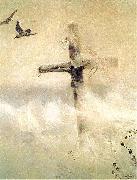 |
Jozef Chelmonski
|
|
(November 7, 1849 - April 6, 1914) was a Polish painter.
Chełmoski was born in the village of Boczki near Łowicz in central Congress Poland, Russian Empire. His first drawing teacher was his father (a small leaseholder and administrator of Boczki village). After finishing high school in Warsaw, he studied in Warsaw Drawing Class (1867-1871) and took private lessons from Wojciech Gerson. From 1871 to 1874 Chełmoski lived in Munich. He worked with Polish painters assembled around Jozef Brandt and Maksymilian Gierymski. He also had studied for a few months at the academy of H. Anschutz and A. Strahuber. In 1872 and 1874 Chełmoski visited the Polish territories. Tatra Mountains and Ukraine.
His first paintings were done under the influence of Gerson. The works that followed were landscapes and villages. In 1875 Chełmoski went to Paris, where he had many important exhibitions and became known to the art scene. With many orders, the artistic level of his paintings decreased.
From 1878 to 1887 Chełmoski visited Poland, Vienna and Venice. In 1887 he returned to Poland and in 1889 settled in Kuklewka Zarzeczna village. Contact with his homeland and nature revealed quality in his artworks. From that time are the best liked Chełmoski's paintings such as Partridge on the Snow, The Storks or Before Thunderstorm.
|
|
 |
Jozef Chelmonski
|
|
(November 7, 1849 - April 6, 1914) was a Polish painter.
Chełmoki was born in the village of Boczki near Łowicz in central Congress Poland, Russian Empire. His first drawing teacher was his father (a small leaseholder and administrator of Boczki village). After finishing high school in Warsaw, Jozef studied in Warsaw Drawing Class (1867-1871) and took private lessons from Wojciech Gerson. From 1871 to 1874 Chełmoki lived in Munich. He worked with Polish painters assembled around Jozef Brandt and Maksymilian Gierymski. There, he also studied for a few months at the academy of H. Anschutz and A. Strahuber. In 1872 and 1874 Chełmoki visited the Polish Territories (Poland, as an independent country, did not exist during this time), Tatra Mountains and Ukraine.
His first paintings were done under the influence of Gerson. The works that followed were landscapes and villages. In 1875 Chełmoki went to Paris, where he had many important exhibitions and became known to the art scene. With many orders, the artistic level of his paintings decreased.
From 1878 to 1887 Chełmoki visited Poland, Vienna and Venice. In 1887 he returned to Poland and in 1889 settled in the village of Kuklewka Zarzeczna. Contact with his homeland and nature are qualities revealed in his artworks. From that time are the best liked, or the most beloved of Chełmoki's paintings are paintings such as Partridge on the Snow, The Storks or Before Thunderstorm.
Chełmoki represented the trend in art called "Polish Patriotic Painting".
He died in Kuklewka near Grodzisk Mazowiecki in 1914.
|
|
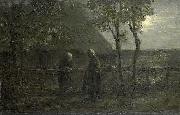 |
Jozef Israels
|
|
(27 January 1824, Groningen - 12 August 1911, Scheveningen) was a Dutch painter, and "the most respected Dutch artist of the second half of the nineteenth century". |
|
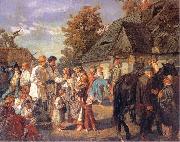 |
jozef marian chelmonski
|
|
Jozef Marian Chełmoski (November 7, 1849 -- April 6, 1914) was a Polish painter.
Chełmoski was born in the village of Boczki near Łowicz in central Congress Poland, Russian Empire. His first drawing teacher was his father (a small leaseholder and administrator of Boczki village). After finishing high school in Warsaw, he studied in Warsaw Drawing Class (1867C1871) and took private lessons from Wojciech Gerson. From 1871 to 1874 Chełmoski lived in Munich. He worked with Polish painters assembled around Jozef Brandt and Maksymilian Gierymski. He also had studied for a few months at the academy of H. Anschutz and A. Strahuber. In 1872 and 1874 Chełmoski visited the Polish territories (Poland as a country did not exist then), Tatra Mountains and Ukraine.
His first paintings were done under the influence of Gerson. The works that followed were landscapes and villages. In 1875 Chełmoski went to Paris, where he had many important exhibitions and became known to the art scene. With many orders, the artistic level of his paintings decreased.
From 1878 to 1887 Chełmoski visited Poland, Vienna and Venice. In 1887 he returned to Poland and in 1889 settled in Kuklewka Zarzeczna village. Contact with his homeland and nature revealed quality in his artworks. From that time are the best liked Chełmoski's paintings such as Partridge on the Snow, The Storks or Before Thunderstorm.
Chełmoski represented the trend in art called "Polish Patriotic Painting".
He died in Kuklewka near Grodzisk Mazowiecki in 1914.
|
|
 |
Jozef Marian Chelmonski
|
|
(November 7, 1849 - April 6, 1914) was a Polish painter.
Chełmoeski was born in the village of Boczki near Łowicz in central Congress Poland, Russian Empire. His first drawing teacher was his father (a small leaseholder and administrator of Boczki village). After finishing high school in Warsaw, Jozef studied in Warsaw Drawing Class (1867-1871) and took private lessons from Wojciech Gerson. From 1871 to 1874 Chełmoeski lived in Munich. He worked with Polish painters assembled around Jozef Brandt and Maksymilian Gierymski. There, he also studied for a few months at the academy of H. Anschutz and A. Strahuber. In 1872 and 1874 Chełmoeski visited the Polish Territories (Poland, as an independent country, did not exist during this time), Tatra Mountains and Ukraine.
His first paintings were done under the influence of Gerson. The works that followed were landscapes and villages. In 1875 Chełmoeski went to Paris, where he had many important exhibitions and became known to the art scene. With many orders, the artistic level of his paintings decreased.
From 1878 to 1887 Chełmoeski visited Poland, Vienna and Venice. In 1887 he returned to Poland and in 1889 settled in the village of Kuklewka Zarzeczna. Contact with his homeland and nature are qualities revealed in his artworks. From that time are the best liked, or the most beloved of Chełmoeski's paintings are paintings such as Partridge on the Snow, The Storks or Before Thunderstorm.
|
|
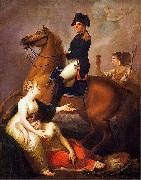 |
Jozef Peszka
|
|
(1767 in Krakew - 1831 in Krakew) was a Polish painter.
He studied painting in Warsaw under Franciszek Smuglewicz. From 1815 he was a professor of painting in Krakew Academy of Arts (Akademia Sztuk Pięknych w Krakowie).
He painted portraits and larger paintings with historical or mythological themes.
|
|
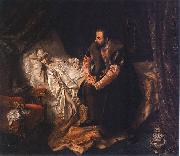 |
Jozef Simmler
|
|
Jozef Simmler (March 14, 1823 - March 1, 1868) was a Polish painter known for his classical style and his Polish subjects.
Perhaps his most famous work is Death of Barbara Radziwillowna. an oil on canvas work completed in 1860. It now hangs in the National Museum, Warsaw. His daughter's brother-in-law was Eduard Strasburger, the famous Polish-German botanist. One of Simmler's grandsons was Henryk Leon Strasburger, a Polish delegate to the League of Nations
|
|
|
|
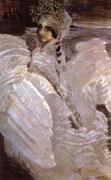 |
Jozsef Rippl-Ronai
|
|
Hungarian Painter, 1861-1927
After his studies at the highschool in Kaposvar he went to study to Budapest, where he got a degree in pharmacy. In 1884 he travels to Munich to study painting at the Academy. 2 years later he gets a grant and that makes him able to move to Paris and study by Munkacsy. In 1888 he meets with the members of Les Nabis and under their influence he paints his first important work The Inn at Pont-Aven, a very deep paining with dark atmosphere. His first big success was the paining My Grandmother (1894).
Later he travels back to Hungary, first the critics does not accept him very warmly, but finally he celebrates a success with the exhibition Rippl-Ronai Impressions 1890-1900. He believes that for an artist there is important not only his work, but also how he lives and what he wears. That is why he becomes also a designer (Andrassy dining room and the window-pane in the Ernst Museum). His exhibitions in Frankfurt, Munich and Vienna have got a great success in 1911-1913. He paints his last big work in 1919 (portrait of his friend Zorka) and in 1927 dies in his villa Roma in Kaposvar. |
|
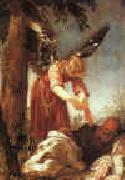 |
Juan Antonio Escalante
|
|
Spanish Baroque Era Painter, 1633-1670
Spanish painter. He was an outstanding figure in decorative Baroque art. When quite young he moved from Andalusia to Madrid, where he apparently worked with and was influenced by Francisco Rizi. His artistic development reveals an increasing admiration for Veronese, Tintoretto and Titian, although elements of the style of Alonso Cano persist. Among his first works is Andromeda and the Dragon (c. 1659; Madrid, Prado), whose mannerist elements derive from an engraving of the subject by Agostino Carracci. The two brilliant works St Catherine of Alexandria (Madrid, Las Maravillas) and Road to Calvary (Madrid, Real Acad. S Fernando), signed and dated 1660, are executed with an agile and self-assured technique, in colours that stem from Venetian painting. Like other Spanish painters of the period, he painted numerous versions of the Immaculate Conception (e.g. 1660, Colegio de Villafranca de los Barros; 1663, Budapest, Mus. F.A.; c. 1666, Benedictine monastery of Lumbier, Navarre), which are more Baroque in style and expression than those of Jose Antolenez and Mateo Cerezo. In these the faces, surrounded by luxuriant hair, is expressed an innocent candour that contrasts with the turbulent appearance of the cherubs. Also characteristic of his style are the versions of the Annunciation (1653; New York, Hisp. Soc. America Mus; B?ziers, Mus. B.-A.). He treated the theme of St Joseph with great nobility, as in the Dream of St Joseph (1666; New York, Chrysler Col.). His deep lyrical feelings pervade the various paintings of the Infant St John (Madrid, Prado). |
|
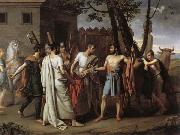 |
Juan Antonio Ribera Y Fernandez
|
|
1779-1860
was a Spanish painter, born at Madrid. He first studied under Francisco Bayeu and enrolled into the Royal Academy of San Fernando, but afterwards went to Paris and become the pupil of Jacques-Louis David. There he painted his Cincinnatus which is now in the Prado Museum. In course of time he went to Rome, and in 1811 was appointed painter to Carlos IV and member of the Academy of St. Luke; and in 1820, honorary member of the Academy of San Fernando. In 1838 he was made professor, and two years afterwards Director of the Prado. He died at Madrid. |
|
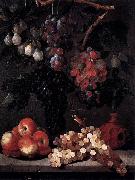 |
Juan Bautista de Espinosa
|
|
(1590-1641, Madrid) was a Spanish still life painter.
More paintings remain of him than biographical data and there is only one known painting remaining.
It is only known that he worked in Toledo and Madrid from 1612 to 1626 and, judging by his style, he was trained in Holland. De Espinosa's style is judged to be the transition from Flemish Baroque to Spanish Baroque.
Several mural paintings in Spanish churches are also attributed to him; one of these is in Alcaudete.
|
|
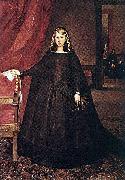 |
Juan Bautista del Mazo
|
|
Juan Bautista Martenez del Mazo (c.1612 - 10 February 1667) was a Spanish Baroque portrait and landscape painter, the most distinguished of the followers of Velezquez, whose style he imitated more closely than did any other artist. A fine painter himself, Mazo was a master of landscape, as proven by his most celebrated work View of Saragossa.
|
|
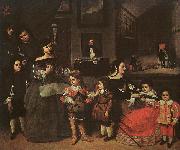 |
Juan Bautista Martinez del Mazo
|
|
1612-1667
Spanish
Juan Bautista Martinez del Mazo Gallery
Mazo??s works owe credit above all to Vel??zquez, whose style he was long compelled to emulate in court portraits. However, Mazo shows in his paintings a personality of his own. His portraits exhibit startling naturalism and marvelously executed. Mazo was specially skillful in painting small figures, a cardinal element in both his hunting scenes and the landscapes he painted as in his most celebrate work View of Saragossa.
Mazo??s palette was rather like that of Vel??zquez, except for a penchant often shown for stressing blue or bluish tints. .The departure from his master style was in his way of shaping people and things by highlights which flash the pictorial image towards the surface of the painting, even from the background.. As a counterbalance, an explicit, even emphatic, perspective design marks out the spatial confines of the composition, making it appear squarish.. A further departure from Velazquez is his luxurious depiction of detail or incident, which he achieved with brilliant, depthless strokes, whether on the figure of a sitter, a curtain on a wall, a floor, the surface of a river, or plain grounds. .These stylistic traits reveal Mazo??s own personality as an artist. .For centuries, Mazo??s paintings were attributed to Vel??zquez, but modern art criticism, techniques and knowledge have been able to separate their works. |
|
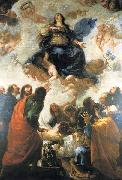 |
Juan Carreno de Miranda
|
|
English: Juan Carreño de Miranda (March 1614-September 1685) was a Spanish painter of the Baroque period.
Español: Juan Carreño de Miranda (Aviles, 1614 - Madrid, 1685) fue un pintor español del siglo XVII, que destace en la Corte española de Felipe IV, y, sobre todo, Carlos II.
|
|
 |
Juan Correa de Vivar
|
|
Spanish , c.1510-1566
was a Spanish painter,Correa's date of birth has been determined to be around 1510. Records show he grew up wealthy. When Juan was 17 or 18 years old he joined an artist workshop in Burgundy where he met with many other Spanish artists at the time, including Pedro de Cisneros whom he befriended. Juan's brother Eufrasia and Eufrasia's son Rodrigo also grew up to be artists. Rodrigo was apprenticed with his uncle, and continued some of his uncle's works after his death. In Mascaraque, Juan was a substantial landowner with a nice house where he did much of his painting. He took frequent trips but always stayed in the Toledo area. Juan was married and a religious man. It can be seen in his testament: a copy was found in the church files of Mascaraque. When he died, Juan split all his possessions between his nephew Rodrigo and the church of Mascaraque. Juan was a well-regarded painter during his life, but many records were lost. His works and life were brought to light again when the researcher and art historian Ceen Bermudez in 1800 published a dictionary of famous artists and included a brief article about his works and Italian influences. The full reconstruction of its biography has been primarily accomplished in the 20th century. Records show Juan died on April 16, 1566 in San Miguel. Juan's body was taken back to Mascaraque where he was buried, in the same plot where his parents were laid to rest. Many members of the artistic community came to the funeral service, |
|
 |
Juan de Espinosa
|
|
Spanish Baroque Era Painter, ca.1590-1641
Spanish painter. Details of his life are scarce. He is documented in Madrid and Toledo between 1612 and 1626, and while he is recorded as having painted religious pictures and portraits (untraced), he is only known today for his still-life paintings. Documents relating to another artist of the same name, known as Juan de Espinosa, dating from 1645 to 1677, concern a different painter. |
|
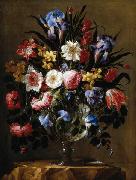 |
Juan de Arellano
|
|
(3 August 1701 - 13 October 1776) was a Spanish painter of the Baroque era who specialized in floral still life paintings.
Born in Santorcaz, near Madrid, where he died. He was a pupil of Juan de Solis. Heavily influenced by Flemish and Italian painters (such as Mario Nuzzi), Juan de Arellano was considered to be exceptional in this thematic. According to one of his colleagues, de Arellano decided to focus exclusively on floral paintings because it offered more pay while requiring less work . Some of de Arellano's most famous pieces include Bouquet of Flowers (c.1660), and Garland of Flowers, Birds and Butterfly, currently on display at the Louvre. He also painted for the sacristy of the church of San Jerenimo el Real of Madrid. See Bodegen for a description of one style of Spanish still life painting. |
|
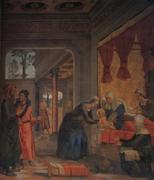 |
Juan de Borgona
|
|
Spanish Painter,
ca.1470-1534
was a High Renaissance painter who was born in the Duchy of Burgundy, probably just before it ceased to exist as an independent state, and was active in Spain from about 1495 to 1534. His earliest documented work was painted in 1495 for the cloister of the Cathedral of Toledo. Borgoña??s compositions are well balanced with finely drawn figures in elegant, tranquil poses. They are set either against open spaces leading on to craggy landscapes or against gold embroidered drapery. There were a number of foreign painters active in Spain in this period, including Juan de Flandes. Borgona??s students include Pedro de Cisneros the Elder (died 1546), Antonio de Comontes (ca. 1500-1519), |
|
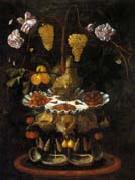 |
Juan de Espinosa
|
|
Spanish Baroque Era Painter, ca.1590-1641, Spanish painter. Details of his life are scarce. He is documented in Madrid and Toledo between 1612 and 1626, and while he is recorded as having painted religious pictures and portraits (untraced), he is only known today for his still-life paintings. Documents relating to another artist of the same name, known as Juan de Espinosa, dating from 1645 to 1677, concern a different painter. |
|
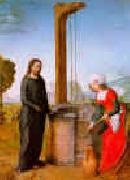 |
Juan de Flandes
|
|
Flemish-born Spanish Northern Renaissance Painter, ca.1460-1519
South Netherlandish painter, active in Spain. Nothing is known of his life or work before he went to Spain, where he is first mentioned in a document of 1496 as Juan de Flandes, a painter in the service of Queen Isabella of Castile. Treasury accounts confirm that he held this position until the Queen death in 1504. On arriving in Spain, he must have lived in Burgos, where he certainly met MICHEL SITTOW, another painter in the Queen service, who had been at the Castilian court since 1492. |
|
|

